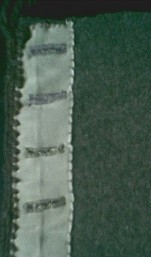Creating a Fourteenth Century Medieval Gown from Primary Sources.The Clothing Finds In 1924 Poul Norlund published a book about the discoveries he had made in Greenland. He found a graveyard of people buried around 1350. One of the most amazing parts of this discovery was that much of the clothing they were buried in was almost intact, and could be exhumed and examined. Norlund's book includes scale drawings of the garments, accurate measurements and interesting commentary about how the garments fit in to our conception of fashion history. They are quite similar to what we think of as cotehardies. These are the only extant examples of male and female dress of this period that we have. See Pictures section:
Between 1972 and 1983 there were a variety of excavations around a small area of London, which seemed mainly to be used as a dump. The items uncovered in these digs are the subject of an excellent series of books put out by the Museum of London. The one that is concerned with cloth artifacts, called Textiles and Clothing (T+C), is an exhaustive look at the fragments that were found in these areas. The book provides many clear pictures of the actual pieces, with descriptions of the cloth and stitches. In 1984 Inga Hagg published a book about some 9th and 10 th century finds at Hedeby (northern Germany). This book is written in a language that I do not understand (German), but it contains some diagrams which have proven very useful. See Pictures section:
Why should all of these sources be used in combination? There are a number of similarities in the shape of the garments found in all of these places. The sleeves of the garments found at Hedeby and even more so in Greenland are cut very much like a modern set in sleeve. The lower, fitted half of the sleeves in London are very similar in shape and finish to those in Greenland. Similar types of fabric buttons are found in both Greenland and London. The stitches used in construction of the garments are quite similar in all three digs. Archeological dating puts both the Greenland and London sites at about the middle of the fourteenth century. Evidence in Manucripts, Effigies, and Statues Dresses with no buttons, or with only sleeve buttons Effigies:
Manuscripts from Grande Chroniques de France around 1380
* * Note that this has men but not women in buttoned tunics. Although the womens' gowns in this manucript are very fitted, there is no sign of where they join, by either buttons or lacing Half-Buttoned Dresses Statue
Effigies
Effigies:
Effigy:
Not Just the Nobles:
Manuscript Tres Riches Heures de Duc de Berry about 1415
Photocopy Bibliography Duby, George Gresham, Colin A. Hagg, Inga Haines, Rev. Herbert Martindale, Andrew Morris, Richard K. Nevinson, J. L. Noel, Jean-Francois; Jahan, Pierre Norlund, Poul Stone, Lawrence Suffling, Ernest R |






